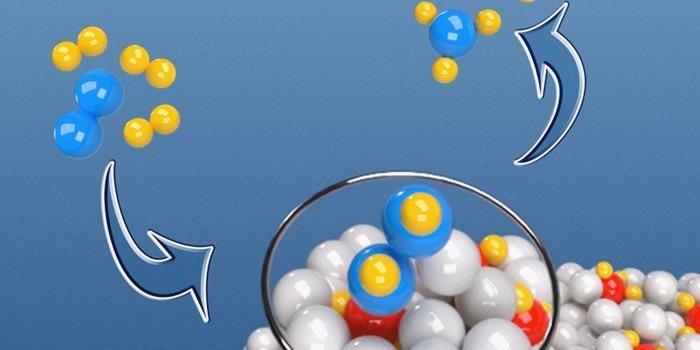Reviewed by Alex SmithNov 22 2021
A computational and experimental study published in the journal Nature Catalysis exhibits the potential for new types of catalysts with the ability to synthesize ammonia under mild conditions.

Image Credit: Technical University of Denmark.
Ammonia production amounts to around 200 megatons annually, which makes it the second-most produced chemical globally, exceeded only by sulfuric acid.
Although ammonia can be produced by various means, the Haber-Bosch process continues to be the most used, for around 90% of the total production. However, Haber-Bosch and other processes involved in industrial-scale production need high temperatures (over 400 °C) and high pressure (over 150 bar). Such conditions are required to break the strong bonds present in nitrogen and react with hydrogen to generate ammonia (NH3).
Such processes, which use up nearly 1% of global energy consumption, are highly based on fossil fuels. Thus, ammonia production is considered to be the most greenhouse gas-intensive chemical-making reaction in the world, summing approximately 1.5% of total global CO2 emissions. Besides, the demand for ammonia is only predicted to increase in the future. This is primarily due to its use in synthetic fertilizers required to feed a rising global population.
One of the major challenges on the climate front, and the energy and food front, is the production of ammonia. Today it is made in some of the largest factories in the world. The only really efficient way to make ammonia is under high temperatures and high pressure and using a carbon-based feedstock.
Tejs Vegge, Professor, VILLUM Center for the Science for Sustainable Fuels and Chemicals (V-Sustain), DTU Energy
Vegge led the study along with Professor Ping Chen from the Dalian Institute of Chemical Physics (DICP), Chinese Academy of Sciences.
Nature is very good at making ammonia at ambient pressure and temperatures in enzymes like nitrogenase. However, the process is very slow and impossible to scale to industrial production.
Tejs Vegge, Professor, VILLUM Center for the Science for Sustainable Fuels and Chemicals (V-Sustain), DTU Energy
Potential Game-Changer
For several decades, researchers have been striving hard to identify new and more sustainable methods for ammonia production. In collaboration with the group from DICP, Tejs Vegge and his colleagues from DTU, Dr Jaysree Pan and Associate Professor Heine A. Hansen, came up with a possible game-changer with a new kind of complex metal hydride catalysts that enabled them to achieve the desired mild-condition ammonia synthesis.
The researchers hope their method could set the stage for new and more sustainable ways of producing ammonia. Their study was reported in the Nature Catalysis journal.
Their process enables ammonia synthesis at temperatures as low as 300 °C and pressures as low as 1 bar. Practical use of such catalysts shows promise regarding small-scale production of ammonia that uses renewable energy. Normally, such systems would need catalysts that work under temperatures below 400 °C and pressures around 50 bar.
“We believe our research stands out in that this new class of catalysts actually lies somewhere between the biological and the industrial processes. It has something from the human, artificial process—heterogeneous catalysis—and something from what goes on in enzymatic and homogenous catalysis. It is an entirely new way of making ammonia, and we’re using the best of both worlds allowing us to lower the temperature and pressure significantly.”
No False Notes
Fundamentally, their alternative type of complicated metal hydride catalysts (Ba2RuH6 and Li4RuH6) can catalyze ammonia formation from nitrogen (N2) and hydrogen (H2). The decrease of nitrogen has been realized through multiple ruthenium hydride complexes, [RuH6]4-, which are rich in hydrogen and electrons.
The hydrogen transports protons and electrons between the center and the nitrogen. Simultaneously, the alkaline metals barium or lithium (Li/Ba) tend to stabilize the reaction intermediates. But the process is highly dynamic; various parts of the complex also serve other functions. It took several years only for the calculations to be completed.
Everything is different from what we’ve seen before. For example, although ruthenium is a well-known component in ammonia catalysis, it is present in a different form and behaves differently.
Tejs Vegge, Professor, VILLUM Center for the Science for Sustainable Fuels and Chemicals (V-Sustain), DTU Energy
Vegge added, “It is surrounded by hydrogen atoms and forms a hydride complex, allowing it to transfer hydrogen in a novel way. You could picture this catalyst as a symphony orchestra, where every part has to function together to make it work. The fascinating part is that it does work—there are no false notes.”
Vegge continued, “Ammonia catalysis is arguably the best-studied catalytic system in the world. To find a truly new mechanism that opens a door into a new world is very satisfying as a scientist. However, it may also open up new possibilities for ammonia production to take place in a less energy-intensive way.”
“The large factories of today are needed to make the production profitable. Our catalysts or similar concepts may enable production in smaller, decentralized factories. This would also cut down on transport, which adds substantially to the price and CO2 emissions of ammonia today," concluded Vegge.
Journal Reference:
Wang, Q., et al. (2021) Ternary ruthenium complex hydrides for ammonia synthesis via the associative mechanism. Nature Catalysis. doi.org/10.1038/s41929-021-00698-8.